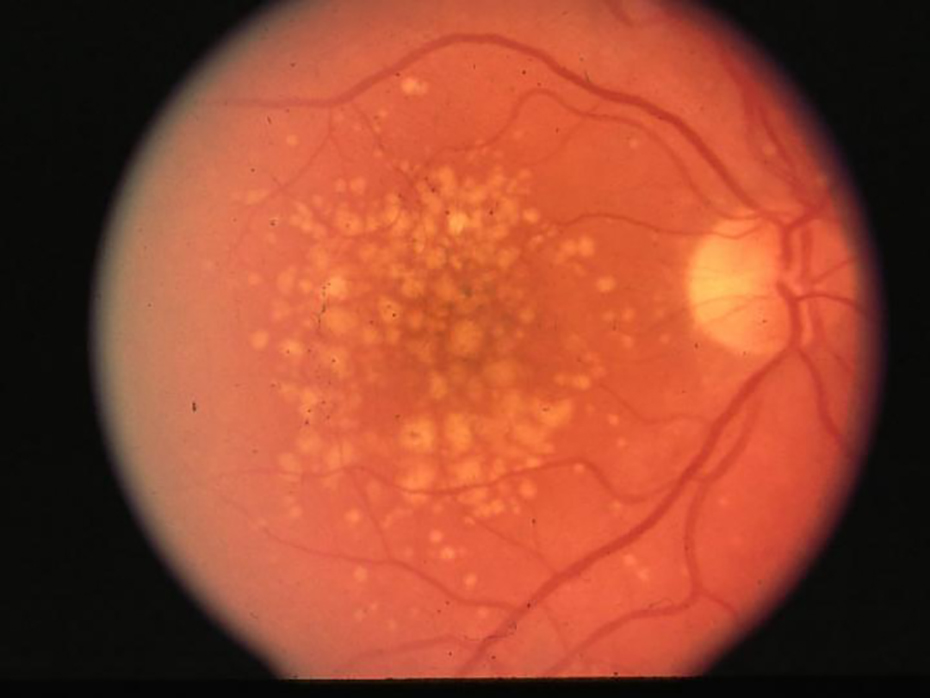
You’ve just had a routine eye exam and your ophthalmologist notices tiny yellow deposits under your retina. Although common in aging eyes, you’re told that these spots, called drusen, may be an early sign of age-related macular degeneration.
Should you be alarmed? What exactly are drusen and what role do they play in the development of AMD, a progressive eye condition that can impair central vision?
“As we get older, the cell layers in the retina may not function as well as before, and waste deposits in the form of fatty proteins begin to build up,” explained retina specialist Christina Flaxel, M.D., director of the Wold Family Macular Degeneration Center at OHSU Casey Eye Institute. ”On their own, drusen usually don’t cause visual problems, and patients may not know they have them until they have a dilated exam.”
However, people with many large, soft deposits clustered together are at higher risk for macular degeneration than those with a few small, scattered drusen, she said. Other factors, such as your age, family history, health habits and environment also contribute to the disease.
A symptom or cause of AMD?
Drusen, first described in 1854, is the plural for the German word “druse,” which means “geode” or “node” in English –“a cavity in rock filled with crystals,” writes Paulus T.V.M. de Jong, in a 2016 article in the journal Ophthalmology and Eye Diseases.
The medical scientist who coined the word in 1856 “probably chose this name because of the crystalline core in some large drusen,” he said.
But it wasn’t until the last century that researchers showed an important connection between drusen and late AMD, said Michael Klein, M.D., director emeritus of the Wold Family Macular Degeneration Center.
A large-scale study called the Complications of Age-Related Macular Degeneration Prevention Trial – or CAPT – helped settle the question about drusen’s effect on AMD. Sponsored by the National Eye Institute, the clinical trial found that low-intensity laser treatments did not prevent complications of AMD or loss of vision. Researchers found no difference in vision or in progression to advanced AMD between treated and untreated eyes.
Casey Eye Institute was one of 22 clinical centers in the U.S. that participated in CAPT, which followed more than 1,000 study patients for at least five years. All the participants had large drusen in both eyes.
“Although the results were not as we hoped, the clinical trial was important in determining that laser therapy is not useful in preventing AMD,” said Klein, who was principal investigator of the study at Casey. However, its data continues to be analyzed, generating additional insights about AMD and its progression, he said.
Drusen’s link to AMD progression is also being examined in the Genetics of AMD Study, a decades-long effort led by Klein and his team at Casey. The study has collected clinical and genetic information from more than 120 families, each noteworthy for having many members with advanced AMD. Researchers will compare their genomes to relatives with large drusen using advanced whole genome sequencing technology. “It will give us valuable information about the genetic similarities between those with large and numerous drusen and their family members who have progressed to late-stage AMD,” he said.
Preventing vision loss
While the presence of drusen may herald the onset of AMD, there are some measures you can take to lessen your risk:
- Adopt a healthy lifestyle. Stop smoking, get plenty of exercise and fill your plate with fruits, vegetables and fatty fish (such as salmon, tuna and sardines). Evidence is emerging that a heart-healthy diet can help protect against AMD.
- Keep an eye on your vision. Be sure to get a dilated eye exam at least annually and monitor your vision at home with an Amsler Grid. This simple tool can pick up on new changes to your vision early on, when treatments are most effective.
- Consider taking AREDS2 dietary supplements, which has been shown to reduce the risk of advanced AMD. These vitamins and minerals cannot be obtained by just the foods you eat. Talk to your eye doctor to see if you are a candidate.
- Protect eyes from damaging light. When outdoors, wear sunglasses that block harmful ultraviolet radiation and blue light waves. People with AMD may want to ask their eye doctor about a prescription for specialized filters to enhance contrast and comfort.